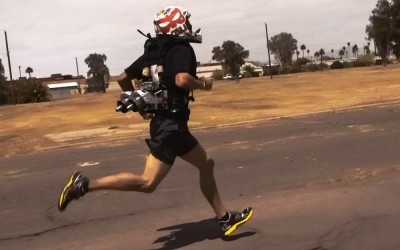
The 4MM jetpack was designed for soldiers by a team at Arizona State University.
Every runner wants to be faster and more efficient. We train for months to lower our times and improve our gait. But imagine immediately being able to reach your goals by simply strapping on a jetpack.
Unlike the futuristic, flying models we immediately envision, the 4MM (four-minute-mile), developed by a team at Arizona State University, is a prototype jetpack made to increase running speed by harnessing energy and propelling runners forward.
The project began a few years ago when ASU professor Thomas Sugar was approached by the Defense Advanced Research Project Agency (DARPA). At the time, Sugar had been making tremendous strides in creating robotic limbs for amputees, but DARPA hoped he would be able to apply that knowledge toward creating a device for able-bodied soldiers. While assembling a team, Sugar decided to reach out to one of his engineering graduate students, Jason Kerestes, who not only was interested in robotics, but was working in welding. Kerestes dove into the project and assumed the role as lead developer.
“The fact that I could work on designing something, and then turn around and weld-up a prototype the next day, or the same day, really reduced our overall time on getting ideas from concept to prototype,” Kerestes explained in an ASU Research video.
The current model of Kerestes’ 4MM is a 11.2-pound pack that is strapped to the wearer’s hips and ankles, and controlled by a second-party handheld. In tests, even with the added weight, the subject was able to shave three seconds off his 200-meter time, and 18 seconds off his mile.
“The big picture goal is really to get soldiers or anybody running in these suits to run and be able to move with abilities that we never thought possible,” Kerestes told Fox News.
The device is able to decreases time, as well as metabolic cost—the amount of energy that the subject needs in order to run at high speeds. In order to reach these speeds, the device also encourages more proper form, something that can easily be seen in test subject Alexander Chapin’s stride in the video.
“In a warfare type of area, this could be the difference between life or death,” Kerestes said. “If you think of a soldier who has to get in somewhere quick […] but maybe get out of there just as quickly. So these devices can help soldiers to not only accomplish their goals and succeed in their missions, but they could potentially save human lives as well.”
The team is still working to increase performance, aiming for that elusive four-minute mark, but their current success signals that the future of running may include jetpacks.
 Your Privacy Choices
Your Privacy Choices
 The
The